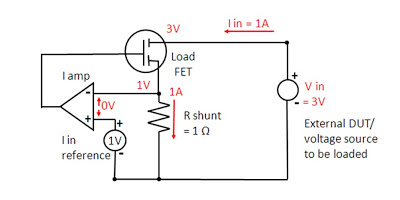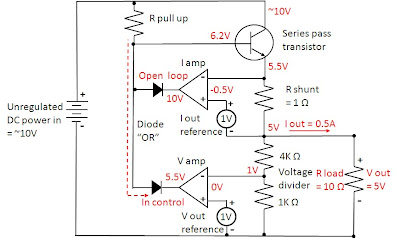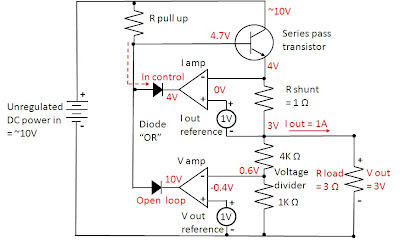In a sense electronic loads are the antithesis of power
supplies, i.e. they sink or absorb power while power supplies source power. In
another sense they are very similar in the way they regulate constant voltage
(CV) or constant current (CC). When used to load a DUT, which inevitably is
some form of power source, conventional practice is to use CC loading for devices
that are by nature voltage sources and conversely use CV loading for devices
that are by nature current sources. However most all electronic loads also feature
constant resistance (CR) operation as well. Many real-world loads are resistive
by nature and hence it is often useful to test power sources meant to drive such
devices with an electronic load operating in CR mode.
To understand how CC and CV modes work in an electronic
load it is useful to first review a previous posting I wrote here, entitled
“How Does a Power Supply Regulate It’s Output Voltage and Current?”. Again, the
CC and CV modes are very similar in operation for both a power supply and an
electronic load. An electronic load CC mode operation is depicted in Figure 1.
Figure 1: Electronic load circuit, constant current (CC)
operation
The load, operating in CC mode, is loading the output of
an external voltage source. The current amplifier is regulating the electronic
load’s input current by comparing the voltage on the current shunt against a
reference voltage, which in turn is regulating how hard to turn on the load FET.
The corresponding I-V diagram for this CC mode operation is shown in Figure 2.
The operating point is where the output voltage characteristic of the DUT
voltage source characteristic intersects the input constant current load line
of the electronic load.
Figure 2: Electronic load I-V diagram, constant current
(CC) operation
CV mode is very similar to CC mode operation, as depicted
in Figure 3. However, instead of monitoring
the input current with a shunt voltage, a voltage control amplifier compares
the load’s input voltage, usually through a voltage divider, against a
reference voltage. When the input voltage signal reaches the reference voltage
value the voltage amplifier turns the load FET on as much as needed to clamp
the voltage to the set level.
Figure 3: Electronic load circuit, constant voltage (CV)
operation
A battery being charged is a real-world example of a CV
load, charged typically by a constant current source. The corresponding I-V
diagram for CV mode operation is depicted in figure 4.
Figure 4: Electronic load I-V diagram, constant voltage
(CV) operation
But how does an electronic load’s CR mode work? This
requires yet another configuration, as depicted in figure 5. While CC and CV modes
compare current and voltage against a reference value, in CR mode the control
amplifier compares the input voltage against the input current so that one is
the ratio of the other, now regulating the input at a constant resistance
value. With current sensing at 1 V/A and
voltage sensing at 0.2 V/V, the electronic load’s resulting input resistance value is 5 ohms for its CR mode
operation in Figure 5.
Figure 5: Electronic load circuit, constant resistance
(CR) operation
An electronic load’s CR mode is well suited for loading a
power source that is either a voltage or current source by nature. The
corresponding I-V diagram for this CR mode for loading a voltage source is
shown in Figure 6. Here the operating point is where the output voltage
characteristic of the DUT voltage source intersects the input constant
resistance characteristic of the load.
Figure 6: Electronic load I-V diagram, constant
resistance (CR) operation
As we have seen here an electronic load is very similar
in operation to a power supply in the way it regulates to maintain constant
voltage or constant current at its input.
However many real-world loads exhibit other characteristics, with
resistive being most prevalent. As a result most all electronic loads are
alternately able to regulate their input to maintain a constant resistance
value, in addition to constant voltage and constant current.









